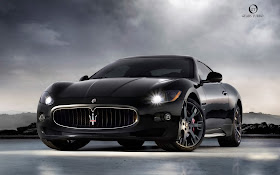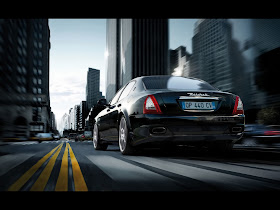| Founded | 1 December 1914 Bologna |
|---|---|
| Headquarters | Modena, Italy |
| Key people | Sergio Marchionne (Chairman) Harald J. Wester (CEO) |
| Products | Automobiles |
| Production output | 5,675 units (2010) |
| Revenue | |
| Owner(s) | Fiat S.p.A. |
| Employees | 696 (2010) |
| Parent | Fiat S.p.A. |
| Website | Maserati.com |
HIGH DEFINITION IMAGES-OPEN IMAGES IN A NEW TAB
Maserati is an Italian luxury car manufacturer established on December 1, 1914, in Bologna. The company's headquarters is now in Modena, and its emblem is a trident. It has been owned by the Italian car giant Fiat S.p.A. since 1993. Inside the Fiat Group, Maserati was initially associated with Ferrari S.p.A., but more recently it has become part of the sports car group including Alfa Romeo.The Maserati brothers, Alfieri, Bindo, Carlo, Ettore, and Ernesto were all involved with automobiles from the beginning of the 20th century. Alfieri, Bindo and Ernesto built 2-litre Grand Prix cars for Diatto. In 1926, Diatto suspended the production of race cars, leading to the creation of the first Maserati and the founding of the Maserati marque. One of the first Maseratis, driven by Alfieri, won the 1926 Targa Florio. Maserati began making race cars with 4, 6, 8 and 16 cylinders (two straight-eights mounted parallel to one another). Another Maserati brother, Mario, an artist, is believed to have devised the company's trident emblem, based on one the Fontana del Nettuno, Bologna. Alfieri Maserati died in 1932, but three other brothers, Bindo, Ernesto and Ettore, kept the firm going, building cars that won races.
The war then intervened, Maserati abandoning cars to produce components for the Italian war effort. During this time, Maserati worked in fierce competition to construct a V16 towncar for Benito Mussolini before Ferry Porsche of Volkswagen built one for Adolf Hitler. This failed, and the plans were scrapped. Once peace was restored, Maserati returned to making cars; the Maserati A6 series did well in the post-war racing scene.
Key people joined the Maserati team. Alberto Massimino, an old Fiat engineer, with both Alfa Romeo and Ferrari experiences oversaw the design of all racing models for the next ten years. With him joined engineers Giulio Alfieri, Vittorio Bellentani, and Gioacchino Colombo. The focus was on the best engines and chassis to succeed in car racing. These new projects saw the last contributions of the Maserati brothers, who after their 10-year contract with Orsi expired went on to form O.S.C.A.. This new team at Maserati worked on several projects: the 4CLT, the A6 series, the 8CLT, and, pivotally for the future success of the company, the A6GCM.
The famous Argentinian driver Juan-Manuel Fangio raced for Maserati for a number of years in the 1950s, producing a number of stunning victories including winning the world championship in 1957 in the Maserati 250F alongside Toulo de Graffenried, Louis Chiron, Prince Bira, Enrico Platé, and a few others. Other racing projects in the 1950s were the 200S, 300S (with several famous pilots, among them Benoit Musy), 350S, and 450S, followed in 1961 by the famous Tipo 61.
Maserati had retired from factory racing participation because of the Guidizzolo tragedy during the 1957 Mille Miglia, though they continued to build cars for privateers. After 1957, Maserati became more and more focused on road cars, and chief engineer Giulio Alfieri built the 6-cylinder 3500 2+2 coupé, which featured an aluminum body over Carrozzeria Touring's superleggera structure, a design also used for the small-volume V8-powered 5000. Next came the Vignale-bodied Sebring, launched in 1962, the Mistral Coupé in 1963 and Spider in 1964, both designed by Pietro Frua, and also in 1963, the company's first four-door, the Quattroporte, designed by Frua as well. The two-seat Ghibli coupé was launched in 1967, followed by a convertible in 1969.
New models included the Maserati Bora, the first mass-produced mid-engined Maserati, in 1971, and the Maserati Merak and Maserati Khamsin soon afterwards; the Maserati Quattroporte II, which shared some parts with Citroën SM, never came into production, although seven were made to special order.
The 1973 oil crisis, however, put the brakes on this ambitious expansion when the demand for fuel-hungry sports cars shrank. Citroën went bankrupt in 1974 and on 23 May 1975, the new controlling group PSA Peugeot Citroën declared that Maserati was also in administration. Propped up by Italian government funds (GEPI, Societa di Gestioni e Partecipazioni Industriali dello Stato Italiano), the company was kept in business.
The Maserati engine and its associated gearbox have been used in other vehicles such as Special Rally prepared Citroën DS, as used by Bob Neyret in Bandama Rally or in the Ligier JS 2.
In 1998, a new chapter began in Maserati's history when the company launched the 3200 GT. This two-door coupé is powered by a 3.2 L twin-turbocharged V8 which produces 370 hp (276 kW); the car does 0–60 mph in 5.5 seconds. Its top speed is 285 km/h (177 mph). It was replaced by the Maserati Spyder and Coupé in the 2002 model year, which in turn were replaced by the GranTurismo and GranCabrio.
More recently, Maserati discussed an agreement with Volkswagen for the German company to share its Audi division's Quattro all-wheel-drive technology (originally meant for the still-born Maserati Kubang sport utility vehicle concept) for Maserati's current Quattroporte platform. This idea has since been abandoned because Volkswagen owns two of Ferrari's direct rivals, Lamborghini and Bugatti.
Meanwhile two new models have been shown to the public: the MC12 road supersports and successful GT racer with a Ferrari Enzo–derived chassis and engine. And the Quattroporte, a high luxury saloon with the 4.2l V8 engine. Maserati is nowadays back in the business, very successfully selling on a global basis. In 2001 Ferrari decided to throw away all the old tooling and installed high-tech devices in the Modena factory, making it one of the most advanced in the world.
Since early 2002 Maseratis are once again being sold in the United States market, which has quickly become for Maserati the largest market worldwide. The company has also re-entered the racing arena with their Trofeo and, in December 2003, the Maserati MC12 (formerly known as the MCC), which was developed according to FIA GT regulations and has since competed with great success in the world FIA GT championship, winning the teams championship three consecutive times from 2005 to 2007. The MC12 has also been raced in various national GT championship as well as in the American Le Mans series. The MC12 is based on the Enzo Ferrari sports car;50 street-legal homologation models (roadsters and coupes) have been sold for about US$700,000 each.
HIGH DEFINITION IMAGES-OPEN IMAGES IN A NEW TAB























































No comments:
Post a Comment